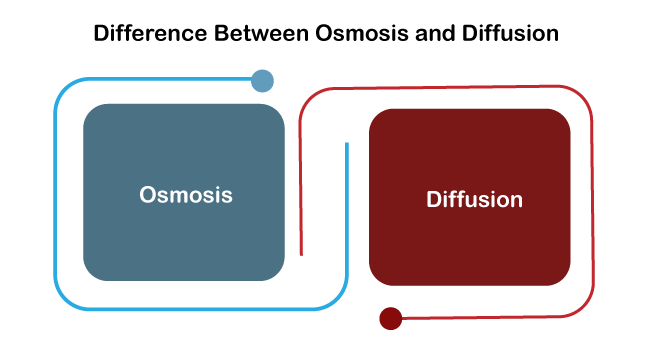Difference between Osmosis and DiffusionWe have often heard certain terms in our science lectures that we remember in a certain way. There are several terms which help in our daily lives as well. Out of these terms, osmosis and diffusion are such terms. Many of us might not know what these two terms mean. So, let us begin our discussion by knowing each of these terms separately and then knowing the difference between the two. Osmosis is defined as the movement of the solvent molecules through a permeable membrane. The solvent further moves into a much higher solute concentration. This spontaneous movement helps to equalize the concentration on both sides. Now, what is a solvent? Any substance that dissolves completely with the solute is called a solvent. The solvent is water in all biological systems. 
The final result of the combination of solvent and solute is called a solution. Solvents are majorly used in paints and inks. Osmosis is a physical process. In layman's language, osmosis is defined as the process wherein the solvent moves through the membrane, thereby separating the two concentrations. Osmosis works under Osmotic Pressure. Now, osmotic pressure is a kind of external pressure used to stop the solvent's movement from moving it into the membrane. This kind of pressure often depends upon the substance concentration. Substance concentration is used to measure the concentration of the solute. Osmosis is one of the important processes in biology as the process of osmosis undergoes through semi-permeable membranes. Molecular substances such as ions, proteins, etc., cannot pass through these membranes. These molecular substances are only permeable in lipids like oxygen, nitrogen, carbon dioxide, etc. The penetration of these molecules depends upon the solubility of the substance, along with the size of the solute. For instance, the water molecule travels through the plasma membrane. Well, osmosis is one of the primary methods used for transporting water into cells. This method is also used for releasing the water out of cells too. Now, let us discuss some historical points regarding osmosis.
These are some of the historical points regarding osmosis. Now, let us look at the how the osmosis process works. The osmosis process mechanism is shown in both biology and chemistry textbooks, wherein there is a dilution of water by the solute. Here, water is the solvent that dilutes with the solute to give us a solution. For instance, when we pour salt into water, it dissolves with the water molecule. On the other hand, if we put oil in water, it will not dissolve with the water molecules. Thus dilution will not take place under such conditions. Well, it is interesting to note that the osmotic pressure supports the plants in a major way. There are three kinds of solution in osmotic pressure, i.e., hypertonic, hypotonic, and isotonic. When a plant cell is placed in a hypertonic solution, the water is released from the cell, resulting in cell shrinking. On the other hand, when a plant cell is placed in a hypotonic solution, the water is moved into the cell, resulting in swelling of the cell. In layman's language, this means that when a cell is diluted with a solute having a higher concentration, the cell shrinks. On the other hand, when a cell is diluted with a lower concentration solute, the cell swells up. In severe situations, the cell may even burst. Now, let us talk about diffusion. Diffusion is completely different from osmosis. In diffusion, there is the movement of any molecule irrespective of solvent or insolvent. Atoms, ions, etc., are transferred from solute of higher concentration to lower concentration. Physics, Biology, Chemistry, Economics, etc., use the concept of diffusion vividly. The main aim of diffusion is to have a solution of higher concentration. The word diffusion comes from the Latin word 'diffunderes,' meaning 'to spread out.' There are two types of diffusion processes, i.e., Fickian Diffusion and Non-Fickian Diffusion. Fickian diffusion is called normal diffusion because there is a proportion between the molar fluxes. Molar flux is a process from which the substance is passed through one concentration to another. The non-fickian diffusion is called anomalous diffusion because of the non-linear proportion between the substances. This concept is used in science and mathematics, wherein the passing of the substances is not proportional. Now, let us see some historical points regarding diffusion.
These are some of the historical points regarding diffusion. Now, what are the differences between the two terms? The major differences between osmosis and diffusion are given below.
These are some of the major differences between osmosis and diffusion. Both osmosis and diffusion are different processes that involve molecular reactions when they are dissolved with the solute of high and low concentration. Thus, both osmosis and diffusion are separate processes as they react differently when placed with different solutes.
Next TopicDifference between
|
 For Videos Join Our Youtube Channel: Join Now
For Videos Join Our Youtube Channel: Join Now
Feedback
- Send your Feedback to [email protected]
Help Others, Please Share









